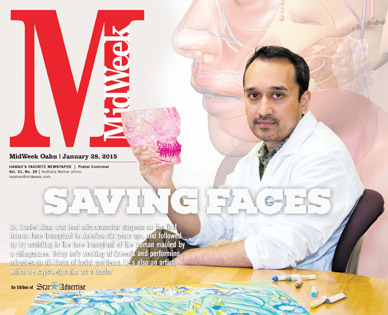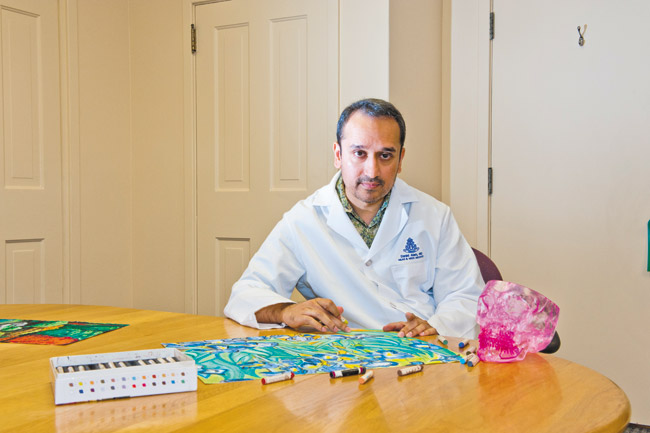Saving Faces
Airwaves and print media were flooding the news into every astonished household: America had performed its first face transplant. A team out of Cleveland Clinic in Ohio had successfully transferred a human face from one body onto another. With that, suddenly sci-fi was real.
mw-cover-012815-daniel-alam-hero-nw-1
Barely six years have passed since lead microvascular surgeon Daniel Alam — along with a total of six other surgeons, four anesthesiologists and 16 nurses — toiled from 7 p.m. one evening to 3 p.m. the next, accomplishing the impossible. Reconstructive surgery was nothing new in the medical community, and with growing expertise in the field, a face transplant was an inevitable outcome. But the novelty and sheer sensationalism of the idea raised an avalanche of questions for the public: What does it even mean to move a face from one body to another? How is it done? Whose faces are involved? How much of the face? Not to mention any ethical quandaries.
Alam, who recently moved to Hawaii, sat down with MidWeek to talk about that first groundbreaking procedure and how he’s using those same reconstructive skills to help patients in our community suffering from facial injuries and cancer deformities.
“With betel nut use and smoking, you’re going to get an incidence in the population of people with palatal tumors,” says Alam, adding that it’s not that there’s a high population of such patients in Hawaii, but that without anyone of Alam’s expertise, people were either resigning themselves to live with these major facial cancers or going to the Mainland to have them treated.
And so, during one of the keynote speeches that he delivers around the world throughout the year, he lectured in Hawaii and was subsequently recruited to move to the Islands by The Queen’s Medical Center. He has since joined a multidisciplinary team at Queen’s to help put together a new Head and Neck Institute. As a head and neck cancer and reconstructive surgeon there, he’s been even busier than expected keeping up with much needed surgeries.
From a historical perspective, reconstructive surgery has been around since ancient times. For example, in India, when a criminal’s nose was cut off as punishment, a flap was cut from the person’s forehead and sewn over the wound. The process evolved further while treating injuries in World War I with temporarily attached pedicle flaps, and was revolutionized in the 1980s.
“That was when we developed the ability, with microscopes, to detach tissue with blood vessels and do little transplants in your own body,” says Alam. “That’s the kind of case I do at Queen’s. Previously, if somebody had a cancer in their jaw, you took the jaw and the inside of the face out. They would be left totally disfigured. They were the people you rarely see because they didn’t leave home, and when you did see them, their jaw was all sunken in. Now we can take the bone from their leg, from their fibula, and take skin, muscle, tissues, and layer by layer rebuild their face.”
A face transplant (taking the face from a donor) is technically easier than facial reconstructions, which use material from one’s own body, but the repercussions are far more complex. That first case in the U.S. was performed on a woman named Connie Culp, who had been shot by her husband. The central area of her face was caved in, with no underlying supporting bone structure. She couldn’t speak, eat without a feeding tube or breathe on her own.
Over a period of four years, says Alam, “she’d had multiple reconstructive surgeries that had failed.”
Then she met Alam and the folks at Cleveland Clinic, who felt compelled to help her — and who had a monetary grant from the Department of Defense and the skills needed to succeed. When a donor became available ― someone who was brain dead and matched the gender, age and coloring of the recipient ― the team prepped Culp for surgery in one room, cleaning the debris from her face, while in an adjacent operating room, Alam harvested the donor’s face.
“You have to preserve the nerves, blood supply, muscles,” he notes. “You’re taking it off as a unit ― the face, jaw, all of the facial skeleton, the entire nose.”
When he transferred the face to Culp’s body, he admits to a moment of anxiousness. He recalls thinking: “This is never going to work!” The face resembled a pale, latex movie mask. He pressed on, carefully lining up the bones and joining them with plates and screws, then he sewed the blood vessels together, and the nerves. When he opened the vascular clamps:







